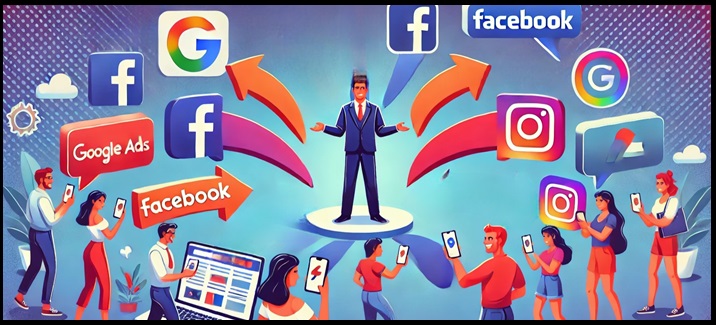
Why Your Business Needs a Multi-Platform PPC Strategy: Google Ads & Facebook/Instagram
In today’s fast-paced digital world, a one-size-fits-all approach to marketing just doesn’t cut it. To grow your business and reach the right audience at the right time, you need to be where your potential customers are. That’s why a multi-platform PPC strategy—using both Google Ads and Facebook/Instagram Ads—is key to driving results and staying ahead of the competition.
Let’s break down why your business should embrace a multi-platform PPC approach and how it can unlock exponential growth.
1. Reach Customers Across Multiple Channels
Your potential customers aren’t limited to a single platform. Some may be actively searching for your services on Google, while others are scrolling through their social feeds on Facebook or Instagram. By advertising across both platforms, you maximize your visibility and capture customers at every stage of their journey.
- Google Ads excels at capturing high-intent users who are searching for immediate solutions like “electrician near me” or “HVAC repair services.”
- Facebook/Instagram Ads focus on building brand awareness and engaging potential customers through visually compelling ads, reaching people who might not even realize they need your services yet.
Combining these two platforms ensures that you’re meeting your audience where they spend their time, whether they’re actively searching or passively browsing.
2. Target Your Audience with Precision
Each platform offers unique targeting capabilities that allow you to refine your reach. With Google Ads, you can target based on search intent, location, and device type, ensuring your ads are seen by users actively looking for your products or services.
Meanwhile, Facebook and Instagram allow for granular targeting based on user behavior, interests, and demographics. Want to target homeowners in a specific neighborhood who are interested in home improvement? Meta’s detailed targeting options make that possible.
With a multi-platform strategy, you can leverage Google’s powerful search-based targeting alongside Facebook/Instagram’s interest-based targeting, giving you the ability to reach different segments of your audience in a way that no single platform could.
3. Increase Brand Awareness and Build Trust
A key benefit of running ads on both Google and Meta platforms is the ability to reinforce your brand message across different touchpoints. When users see your business on Google during a search and later encounter your ad on Facebook or Instagram, it creates a sense of familiarity and trust.
This kind of multi-touch approach helps build brand recognition and ensures that when potential customers are ready to make a decision, your business is top of mind.
- A customer might search for “emergency plumber” on Google, click on your ad, and then see your Instagram ad promoting special discounts. This multi-platform presence builds trust and reinforces your credibility.
4. Capture High-Intent and Discovery-Based Leads
One of the key reasons to use both Google Ads and Facebook/Instagram Ads is that they serve different purposes in the customer journey.
- Google Ads is perfect for capturing high-intent leads—people who are already searching for a solution and are ready to take action.
- Facebook/Instagram is ideal for discovery-based leads, where people may not be actively searching but are drawn in by your ad’s visual appeal or special offer.
This combination of intent-driven and discovery-based marketing ensures you capture leads at every stage—whether they’re ready to buy now or need more nurturing.
5. Optimize Campaigns Based on Data from Both Platforms
A multi-platform strategy also gives you insightful data from two of the most powerful ad networks in the world. Google’s robust data analytics help you fine-tune your keyword strategies and bidding tactics, while Facebook/Instagram’s detailed audience insights reveal user behaviors, engagement patterns, and preferences.
By analyzing the performance of your campaigns across both platforms, you can:
- Identify which platform drives more conversions and shift budget accordingly.
- Test different ad formats and messaging to see what resonates best with your audience.
- Use retargeting on both platforms to re-engage users who’ve interacted with your brand.
With a multi-platform PPC strategy, you’re always improving and optimizing based on actionable data.
6. Diversify Your Marketing for Better Stability
Relying on a single platform for lead generation can be risky. If there are changes in algorithms, ad policies, or audience behavior, your business could be left scrambling. A multi-platform strategy provides diversification that shields you from disruptions on any one platform.
- If Google Ads performance dips due to algorithm updates or seasonal shifts, your Facebook/Instagram ads can keep driving traffic and vice versa.
- Diversifying across platforms means that even if one channel underperforms, your business is still generating leads through the other.
This approach ensures greater stability in your lead generation efforts and helps future-proof your marketing strategy.
Conclusion: Maximize Your Growth with a Multi-Platform PPC Strategy
If you want to maximize leads, conversions, and overall business growth, a multi-platform PPC strategy is essential. By leveraging the strengths of both Google Ads and Facebook/Instagram, you can reach more customers, build brand awareness, and optimize campaigns for the best possible ROI.
Ready to unlock the full potential of PPC for your business? Contact Memetic Consulting today to get started with a custom multi-platform strategy designed to grow your business.
